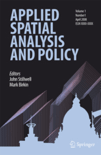
Applied Spatial Analysis and Policy
Scope & Guideline
Advancing spatial insights for impactful policy.
Introduction
Aims and Scopes
- Spatial Analysis Methodologies:
The journal covers a wide range of spatial analysis techniques, including geostatistics, spatial econometrics, and GIS-based methods, to analyze and visualize spatial phenomena. - Urban and Regional Planning:
Research often focuses on urban development, land use, and regional planning, addressing the spatial dynamics of cities and their surrounding areas. - Environmental Policy and Management:
Papers frequently explore the intersection of spatial analysis and environmental issues, such as climate change, pollution, and resource management, offering insights for sustainable practices. - Health and Social Policy:
The journal examines the spatial dimensions of public health and social inequalities, emphasizing how geographic factors influence health outcomes and access to services. - Economic Development:
Research includes studies on economic patterns, industrial clustering, and the spatial distribution of resources, contributing to understanding regional economic dynamics. - Transportation and Mobility:
The journal investigates the spatial aspects of transportation systems, including accessibility, public transit, and the impact of infrastructure on mobility patterns. - Community Engagement and Participation:
Research often highlights the role of community input in spatial planning processes, utilizing participatory GIS and public engagement methodologies.
Trending and Emerging
- COVID-19 Impact Studies:
Research examining the spatial impacts of the COVID-19 pandemic, including analyses of urban decline, public health access, and economic recovery, has surged, reflecting the pandemic's profound effects on spatial dynamics. - Climate Change and Environmental Justice:
There is an increasing emphasis on studies that explore the spatial dimensions of climate change and environmental justice, particularly how these issues affect vulnerable populations. - Data-Driven Decision Making:
The integration of big data and advanced analytics in spatial decision-making processes is a growing theme, highlighting the importance of data in informing policy and planning. - Smart Cities and Urban Technology:
Research focusing on smart city initiatives, urban technology, and their spatial implications is gaining traction as cities adopt innovative approaches to urban challenges. - Health Disparities and Accessibility:
Papers addressing spatial health disparities, particularly related to access to healthcare services and the impact of geographic factors on health outcomes, are increasingly prevalent. - Participatory Spatial Planning:
There is a rising interest in participatory planning approaches that involve community engagement and stakeholder input in spatial decision-making processes. - Mobility and Transportation Networks:
Emerging studies are focusing on the spatial analysis of transportation networks, accessibility, and their role in shaping urban mobility patterns.
Declining or Waning
- Traditional Land Use Planning:
There is a noticeable decline in papers focusing solely on traditional land use planning without the integration of advanced spatial analysis techniques, as the field shifts towards more dynamic and data-driven approaches. - Basic Geographic Information Systems (GIS) Applications:
Research that merely describes GIS applications without substantial analytical depth or policy implications is waning, indicating a move towards more complex and integrated spatial analyses. - Historical Spatial Analysis:
Fewer studies are being published that focus on historical spatial analysis alone, as the journal increasingly emphasizes contemporary applications and real-time data analysis. - Single-Factor Economic Analyses:
Papers that analyze economic factors in isolation, without considering the multi-faceted interactions of social, environmental, and spatial variables, are becoming less common. - Static Spatial Models:
The journal is moving away from static models that do not account for temporal changes, reflecting a growing preference for dynamic and adaptive modeling approaches.
Similar Journals

Journal of Geographical Systems
Exploring the Interconnectedness of Human and Physical WorldsJournal of Geographical Systems, published by SPRINGER HEIDELBERG, is a premier platform for disseminating cutting-edge research in the fields of geography, economics, and environmental science. With a strong emphasis on innovative methodologies and interdisciplinary approaches, this journal serves as an essential resource for scholars seeking to explore the complex interactions between human and physical systems in our ever-changing world. The journal’s impressive 2023 Q1 ranking in Geography, Planning and Development and substantial presence in Q2 categories for Earth-Surface Processes and Economics underscore its pivotal role in advancing geographic scholarship. Researchers can benefit from the journal's accessibility through various distribution channels, fostering an inclusive academic discourse. With a commitment to high-impact studies from 1999 to 2024, the Journal of Geographical Systems is a significant avenue for the exchange of ideas and findings that can influence policy and planning at both local and global scales.

GEOGRAFISKA ANNALER SERIES B-HUMAN GEOGRAPHY
Pioneering discussions in the realm of human geography.GEOGRAFISKA ANNALER SERIES B-HUMAN GEOGRAPHY, published by Taylor & Francis Ltd, is a leading academic journal dedicated to advancing the field of human geography. With an ISSN of 0435-3684 and an E-ISSN of 1468-0467, this journal has established its reputation since its inception in 1976. It currently holds a prestigious Q1 ranking in Geography, Planning, and Development, reflecting its significant impact in the academic community with a Scopus rank of #243 out of 821 in its category, showcasing a 70th percentile standing among its peers. The journal aims to publish high-quality, innovative research that enhances our understanding of the complex interactions between humans and their environments. Although it operates on a subscription basis, the rigor of its peer-review process and the quality of published articles make it an essential resource for researchers, professionals, and students alike. By exploring pivotal themes in human geography, the journal not only contributes to academic discourse but also informs policy-making and practical applications in the field.

Letters in Spatial and Resource Sciences
Bridging Disciplines in Geography and Resource ManagementLetters in Spatial and Resource Sciences, published by Springer Heidelberg, is a prestigious journal dedicated to the interdisciplinary exploration of spatial and resource-related issues within the fields of demography, economics, geography, planning, and urban studies. Since its inception in 2008, this journal has provided a platform for cutting-edge research, facilitating the exchange of innovative ideas and methodologies that address contemporary challenges in spatial dynamics and resource allocation. With an impact factor reflecting its robust standing in academic circles (notably ranking Q2 in Demography and Geography, and Q3 in Economics and Econometrics as of 2023), it serves as an essential resource for scholars and practitioners alike. The journal is committed to fostering open dialogue and advancing the understanding of spatial phenomena, making it a vital asset for anyone engaged in these dynamic areas of study. Targeting a diverse audience, from researchers to industry professionals, it aims to enhance scholarly communication and promote evidence-based solutions to spatial and resource dilemmas.
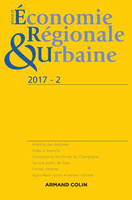
Revue d Economie Regionale et Urbaine
Driving innovation in regional economic research.Revue d Economie Regionale et Urbaine is a prestigious journal published by ARMAND COLIN, dedicated to advancing the field of regional and urban economics. Renowned for its rigorous peer-reviewed articles, this journal provides a vital platform for scholars, practitioners, and students to explore contemporary issues, methodologies, and case studies in regional development, urban policy, and economic geography. With its ISSN 0180-7307 and E-ISSN 2107-0865, the journal facilitates widespread dissemination of knowledge, although it currently does not offer open access options. Situated in Paris, France, Revue d Economie Regionale et Urbaine plays a critical role in fostering dialogue and innovation among academics and policymakers alike, contributing significantly to the understanding and enhancement of urban and regional economies.

Hrvatski Geografski Glasnik-Croatian Geographical Bulletin
Empowering Research with Timely Geographical InsightsHrvatski Geografski Glasnik-Croatian Geographical Bulletin, ISSN 1331-5854, E-ISSN 1848-6401, is an esteemed open-access journal published by the Croatian Geographical Society that has been serving the geography community since 1929. Based in Zagreb, Croatia, this journal focuses on a broad spectrum of geographical research, providing a platform for the dissemination of original articles, reviews, and case studies that contribute to the understanding of earth-surface processes and development planning. Although it currently holds Q4 rankings in both Earth-Surface Processes and Geography, Planning and Development, the journal is dedicated to enhancing its impact within the scientific community, aspiring to elevate research visibility and collaborative opportunities. With a commitment to open access, it ensures that all content is readily available to researchers, professionals, and students worldwide, fostering an inclusive environment for geographical scholarship. Engaging with this journal presents an opportunity to stay updated with emerging trends and pivotal studies within the discipline throughout its converged years from 1998 to 2024, making it a vital resource in geography and related fields.
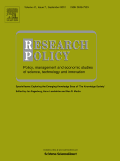
RESEARCH POLICY
Navigating the Landscape of Innovation and Decision-MakingRESEARCH POLICY is a premier academic journal published by Elsevier, dedicated to advancing the study of innovation, technology management, and strategic decision-making. With a distinguished impact factor, this journal is recognized as a Q1 leader in several categories, including Engineering (miscellaneous), Management of Technology and Innovation, Management Science and Operations Research, and Strategy and Management. Since its inception in 1971, RESEARCH POLICY has served as an essential platform for researchers, professionals, and students alike, promoting groundbreaking studies and insightful analysis that shape the future of technology and innovation management. The journal's stringent peer-review process ensures high-quality content, while its varied access options facilitate a wide dissemination of research findings across the globe. Scholars seeking to contribute to the evolving discourse on research policy and innovation will find this journal a vital resource in their academic and professional journeys.

Urban Science
Pioneering Knowledge in Urban Science and DevelopmentUrban Science, published by MDPI in Switzerland, is a pioneering open access journal that has been serving the academic community since 2017. With a robust focus on understanding urban environments through various interdisciplinary lenses such as Environmental Science, Geography, Planning and Development, and Urban Studies, this journal aims to advance knowledge on the complexities of urban living and the challenges that modern cities face. Recognized for its impact, Urban Science holds prestigious rankings, including Q1 in Urban Studies and Q2 in multiple relevant categories. Its presence in leading databases like Scopus, where it stands among the top percentile ranks, underscores its contribution to critical dialogues in urban research. The journal’s commitment to accessibility, targeted toward researchers, professionals, and students alike, fosters an inclusive platform for disseminating innovative ideas and solutions necessary for sustainable urban development.
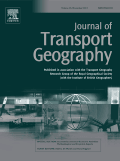
Journal of Transport Geography
Pioneering Research in Transport Systems and Spatial AnalysisThe Journal of Transport Geography, published by Elsevier Ltd, stands as a premier international platform for the dissemination of research at the intersection of transportation and geography. Established in 1993, this journal explores critical issues in transport systems, spatial analysis, and environmental impacts, providing invaluable insights for academics, policymakers, and industry practitioners. With an impressive impact factor and ranking within the top quartiles across multiple categories including Environmental Science and Geography, Planning and Development, the journal is recognized for its rigorous peer-review process and high-quality contributions. As it converges towards the target year of 2024, the Journal of Transport Geography continues to serve as an essential resource for understanding the challenges and innovations shaping transportation landscapes globally. Access to its research is available through traditional subscription models, reinforcing its commitment to supporting the advancement of knowledge in this vital field.
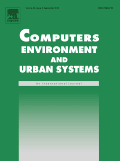
COMPUTERS ENVIRONMENT AND URBAN SYSTEMS
Catalyzing Change in Urban Environments with TechnologyCOMPUTERS ENVIRONMENT AND URBAN SYSTEMS, published by Elsevier Science Ltd, is a premier journal dedicated to advancing the intersection of computational techniques and urban environmental studies. With an ISSN of 0198-9715 and an E-ISSN of 1873-7587, this journal has established itself as a leading publication since its inception, spanning its converged years from 1980 to 1986 and from 1988 to 2024. Operating out of the United Kingdom and located at 125 London Wall, London EC2Y 5AS, the journal boasts impressive rankings, with a Q1 classification in multiple categories including Ecological Modeling and Urban Studies, solidifying its reputation in the academic community. Researchers and professionals engaged in ecological modeling, urban geography, and spatial planning will find a wealth of high-quality research articles that facilitate innovative solutions to contemporary urban challenges. Although the journal does not currently offer open access options, it remains a crucial resource for scholars aiming to contribute to the sustainable development of urban environments.

Raumforschung und Raumordnung-Spatial Research and Planning
Shaping policies through interdisciplinary insights.Raumforschung und Raumordnung - Spatial Research and Planning (ISSN: 0034-0111, E-ISSN: 1869-4179), published by OEKOM VERLAG GMBH, is a prominent scholarly journal based in Germany, focusing on critical issues in spatial research and planning. Established in 1977, this Open Access journal has been providing free access to its content since 1998, allowing researchers, professionals, and students to engage with high-quality studies exploring the intricacies of urban studies, environmental science, and geography. With a notable impact in its field, evidenced by its Q2 ranking in Urban Studies and Q3 rankings in Earth and Planetary Sciences, the journal plays a vital role in fostering interdisciplinary dialogue, advancing knowledge, and influencing policies across various spatial domains. It continues to evolve and adapt, having converged its years of publication effectively, making it a valuable resource for anyone looking to stay informed on the latest trends and research within the realms of spatial planning and environmental analysis.